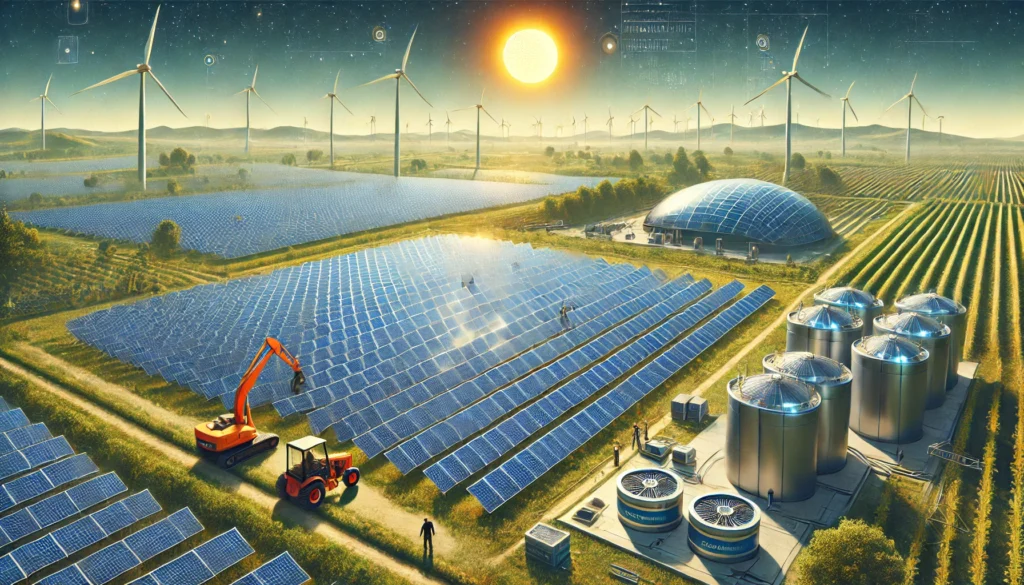India’s renewable energy market has seen record growth in 2024 with the nation adding 25.2 GW of solar capacity, a 204% rise over 2023. This huge growth, as quoted by Mercom, is the largest capacity addition in a year in Indian history. Solar power generation saw a huge rise primarily due to large-scale projects, which covered 87% of the new capacity, with rooftop solar covering 13%.
Government Push: $1 Billion Solar Manufacturing Subsidy
In an effort to cut dependence on Chinese imports, India is closing in on a $1 billion capital subsidy scheme to boost domestic solar production. The initiative, spearheaded by the Ministry of New and Renewable Energy, will offer assistance to local wafers and ingot manufacturers, one of the weakest links in India’s solar supply chain. The subsidy program is set for Cabinet approval sometime in the near future and falls under India’s overall plan for taking advantage of the world’s energy transition.
New Energy Storage Mandate in Solar Tenders
In order to solve intermittency problems in solar power generation, the Indian government has suggested that all Renewable Energy Implementing Agencies (REIAs) and state utilities have a mandatory two-hour energy storage system (ESS) equivalent to 10% of installed solar capacity in all new solar tenders. This action, as per Mercom, will lead to the deployment of 14 GW/28 GWh of energy storage capacity by 2030. The requirement will keep the sun ensuring that solar energy is on tap during non-solar hours, especially during peak demand hours, for the stabilization of the grid.
Major Investments in Solar and Battery Storage
Grew Solar’s 3 GW Factory in Madhya Pradesh
Ahmedabad’s Grew Solar has committed $3.5 billion to setting up a three-stage, backward-integrated solar module factory in Narmadapuram, Madhya Pradesh. Spread over 60 acres, the factory will produce 3 GW of ingots, wafers, and solar cells per year. Upon commissioning, the project is likely to generate more than 1,000 direct jobs in the area. Grew Solar already has a 3 GW unit in Jaipur, and another 5 GW capacity is being developed.
JSW Energy’s 500 MWh Battery Storage System in Kerala
JSW Energy has secured Solar Energy Corporation of India’s (SECI) auction to develop a 125 MW/500 MWh independent battery energy storage system (BESS) in Kerala. JSW Energy bagged the project at a quoted tariff of ₹441,000 (~$5,057)/MW/month and will get viability gap funding of ₹2.7 million (~$30,963)/MWh or 30% of the capital cost of the project, whichever is less. The system will be tied to the Mylatti 220 kV substation in Kasaragod and will be expected to achieve a minimum monthly system availability of 95% while ensuring an 85% AC-to-AC round-trip efficiency.
ONGC’s Renewable Energy Ambitions
Oil and Natural Gas Corporation (ONGC) has revealed its strategy to build 10 GW of renewable energy capacity by 2030, with ₹40,000 crore worth of investment in solar, wind, and green hydrogen projects. As a part of its plan, ONGC recently inked a deal with Ayana Renewables, boosting its clean energy portfolio from 153 MW to 3 GW.
Concurrently, ONGC is stepping up its oil and gas production operations, increasing capital spending over ₹30,000 crore in the ongoing financial year. Investment next year is likely to be ₹35,000-40,000 crore, with emphasis on deepwater drilling, offshore field development, and exploration activities. Major projects are the Daman Upside Development Project (DUDP), which is likely to start production by end-2025, and the Deepwater Cluster-1 project on the East Coast.
Conclusion
India’s record-breaking solar capacity addition, along with government subsidies, energy storage requirements, and big-ticket investments, marks a revolutionary change in the renewable energy ecosystem of the country. With aggressive plans for solar manufacturing, energy storage, and green hydrogen production, India is poised to lower import dependence, increase energy security, and speed up its transition to clean energy.

